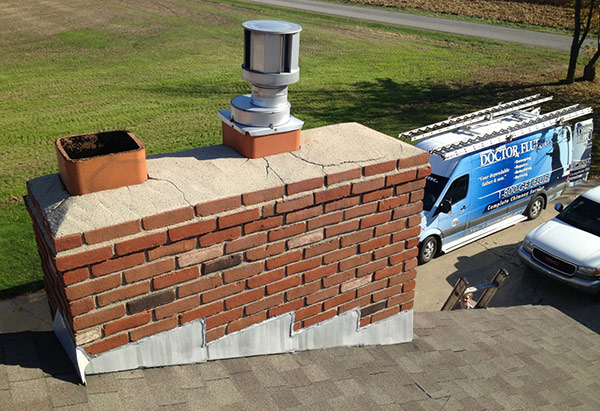
They say a watched pot never boils. While this saying really speaks to impatience more than boiling water, when the Chimney Safety Institute of America (CSIA) says, “Clean chimneys don’t catch fire,” they really are talking about chimneys!
A clean, well-maintained fireplace and chimney is the best way to protect your home and family from fire. While cleaning and repairing your chimney are best left to the professionals, there are a few basics things you can inspect or repair yourself between professional inspections and cleanings.
The Importance of Fireplace & Chimney Maintenance
Just like regularly changing the oil in your car is necessary to avoid engine damage, regular inspections and cleaning for your fireplace and chimney are necessary to avoid chimney fires and other damage. This keeps you and your family safe not to mention the money you save on heating and cooling efficiency when your fireplace is kept in tip-top condition.
Look for Masonry Damage
Some things you can inspect for are loose mortar joints and/or cracks in the masonry. In the firebox, look at the backing, base, and walls for spalling (or flaking) bricks and for mortar that is deteriorating. If you find brick and/or mortar damage, get them repaired as soon as possible.
Test Your Damper
Your damper should open and close easily. A damper that is stuck or hard to open and close could signify rust, which means moisture. This can indicate other issues and should be inspected.
Depending on the type of damper you have, you may be able to visually check the damper if you can see it opening and closing. Can you feel or hear any air when the damper is closed? This is a good indication that the seal is working improperly. If the damper is not sealing correctly, it could be warped or there may be debris preventing it from closing properly.
Check the Roof
If you enjoy heights and are the do-it-yourself (DIY) type, there are a few things you can do to maintain your chimney between professional cleanings and inspections.
- Chimney cap: First, check to be sure your chimney cap is still in place. Harsh winds or other severe weather can rip the cap right off your chimney. If it is missing, or if you never had one, investing in a chimney cap is a wise choice – it is your first defense against water, snow, debris and even animals entering your chimney. If your chimney cap is intact, but shows signs of rust, don’t ignore it. In time, rusted spots can invite animals to work their way into your chimney. If your flue is in good condition, replacing your flue cap could be a DIY project. However it can also easily be replaced during your routine inspection.
- Chimney crown: Inspect the chimney crown for cracks or crumbling in the cement. One small crack is enough to allow moisture in. A crown sealer can be used to repair your chimney crown. A great option is a flexible elastomeric sealant. Simply clean the crown with a nylon brush, fill any cracks with patching cement or 100% silicone caulk, making sure to force it into any cracks.
- Flashing: The flashing protects the chimney where it connects with the roof and prevents moisture damage. If you notice loose or warped flashing, contact your chimney professionals to determine if it can be fixed or needs to be replaced.
- Inspect the masonry: If the masonry is in good condition, you may choose to apply a water-repellent to the brick. Water repellents are different from sealants. They prevent water from entering from the outside while they allow the chimney to “breathe.” If you apply a repellent, be sure to cover adjacent shingles with a tarp.
Note to Ann Arbor residents: if you live in a historic property, there are special guidelines to maintaining your home. If you notice your chimney list, bulge or settle, we can help! Contact Dr. Flue to be sure you are in compliance with Ann Arbor’s Historic Preservation Ordinance.
Look for Evidence of Water Damage or Invading Moisture
Checking for moisture or water damage is an important part of maintaining your fireplace. You may actually hear water dripping, even if you cannot see any water. A musty smell coming from your fireplace is an indication of mold or mildew and, therefore, an indication of unwanted moisture. Other signs include cracks in the masonry or water stains inside the firebox. The best time to inspect for these symptoms of water is after a heavy rain. If you notice any signs of water damage, it is best to address them immediately. Leaky chimneys won’t get better with time, only worse, so set up an inspection right away to avoid further damage to your chimney and your home.
Have Big Repairs Done by a CSIA-Certified Professional
Chimney repairs aren’t all DIY. Testing your damper and inspecting your masonry are certainly things all homeowners can do. Some homeowners can even repair a crack in the chimney crown or apply water repellant to the bricks. But keep in mind that:
- Roof work is dangerous
- Improper repairs could put your home/family at risk
- Specialized tools needed
- CSIA-certified professionals know what to look for to identify current or future problems
Keep your fireplace and chimney in safe working condition by knowing what to look for, handling small repairs yourself if you choose to, and leaving the big repairs to the CSIA-certified professionals.
Schedule Your Annual Chimney Inspection
You’re likely to miss key chimney or fireplace maintenance needs. A professional inspection is necessary every year as part of your maintenance routine to keep your chimney and fireplace operating efficiently and safely.
Now Is a Great Time for a Chimney Inspection – Contact Doctor Flue!
If you have questions about your fireplace or chimney, contact us today! We offer chimney services and products in Michigan and Ohio and can help you avoid common chimney risks so you can have peace of mind.
Call Us: 1-800-438-3583
Email Us: office@drflue.com
Office Hours: Mon-Fri: 8am-4pm

